What a cool story! You know, half the fun (or more) is in the search and acquiring. I can't imagine my folks helping me with a project like that - my dad grumbled hauling me 20 miles into town for a new rear wheel for my motorcycle. That's really cool your mom helping so much with the project.
-
Friends, our 2nd Amendment rights are always under attack and the NRA has been a constant for decades in helping fight that fight.
We have partnered with the NRA to offer you a discount on membership and Muzzleloading Forum gets a small percentage too of each membership, so you are supporting both the NRA and us.
Use this link to sign up please; https://membership.nra.org/recruiters/join/XR045103
You are using an out of date browser. It may not display this or other websites correctly.
You should upgrade or use an alternative browser.
You should upgrade or use an alternative browser.
Full scale cannon re-build
- Thread starter davec2
- Start date

Help Support Muzzleloading Forum:
This site may earn a commission from merchant affiliate
links, including eBay, Amazon, and others.
- Joined
- Mar 7, 2007
- Messages
- 700
- Reaction score
- 2,177
Andy52,
I have never seen a Hern Iron Works barrel in person. From reading their web description, I am a little skeptical because they cast the iron around a steel liner which invites a warped bore as the 2700 degree molten iron hits a room temperature piece of DOM tubing. Even if the bore liner is heated very hot, the center of the cast material (the weakest part of any casting) ends up between the liner outer wall and the outside dimension of the barrel. In the 16th, 17th, and 18th centuries, the strongest way to make a cannon barrel was to cast it solid and then drill the bore. That way the weakest part of the cast material was removed by drilling out the bore. In my opinion, the best way to put a steel liner in a cast iron barrel is to cast the barrel solid, drill out the bore, and then install the steel DOM liner with epoxy. Not that the Hern barrels are not structurally sound....It just that I personally like the more time honored way to produce a strong barrel even before it is lined. You might compare a South Bend Replica cannon barrel to a Hern Iron Works barrel just for your own assesment.
Also, if you do build a caronnade, I would suggest putting it on an appropriate sea carriage rather than a land carriage.....again just my personal preference. I hope this helps
I have never seen a Hern Iron Works barrel in person. From reading their web description, I am a little skeptical because they cast the iron around a steel liner which invites a warped bore as the 2700 degree molten iron hits a room temperature piece of DOM tubing. Even if the bore liner is heated very hot, the center of the cast material (the weakest part of any casting) ends up between the liner outer wall and the outside dimension of the barrel. In the 16th, 17th, and 18th centuries, the strongest way to make a cannon barrel was to cast it solid and then drill the bore. That way the weakest part of the cast material was removed by drilling out the bore. In my opinion, the best way to put a steel liner in a cast iron barrel is to cast the barrel solid, drill out the bore, and then install the steel DOM liner with epoxy. Not that the Hern barrels are not structurally sound....It just that I personally like the more time honored way to produce a strong barrel even before it is lined. You might compare a South Bend Replica cannon barrel to a Hern Iron Works barrel just for your own assesment.
Also, if you do build a caronnade, I would suggest putting it on an appropriate sea carriage rather than a land carriage.....again just my personal preference. I hope this helps
- Joined
- Mar 7, 2007
- Messages
- 700
- Reaction score
- 2,177
Dude,
Yes....both my folks were a great help on any crazy project I came up with. My Dad drilled most of the long holes for the bolts that hold the cheeks on the carriage and the trail on the axel with a hand brace and bit. He must have done it for me because I cannot imagine how I could have drilled those 3/4" holes nice and straight through, in some cases, 15 inches of oak and made the other end of the hole come out where it was supposed to. He could do that sort of thing and make it look easy.... He passed away a few years ago at the age of 91 and was working right up to the last few weeks of his life. My Mom is 96 and she is still helping me with moral support...
He passed away a few years ago at the age of 91 and was working right up to the last few weeks of his life. My Mom is 96 and she is still helping me with moral support... I did a great job picking out an excellent pair of parents !!!
I did a great job picking out an excellent pair of parents !!!
Yes....both my folks were a great help on any crazy project I came up with. My Dad drilled most of the long holes for the bolts that hold the cheeks on the carriage and the trail on the axel with a hand brace and bit. He must have done it for me because I cannot imagine how I could have drilled those 3/4" holes nice and straight through, in some cases, 15 inches of oak and made the other end of the hole come out where it was supposed to. He could do that sort of thing and make it look easy....
Thank you, sir. My intentions were to build a naval carriage considering I'm an old salt.Andy52,
I have never seen a Hern Iron Works barrel in person. From reading their web description, I am a little skeptical because they cast the iron around a steel liner which invites a warped bore as the 2700 degree molten iron hits a room temperature piece of DOM tubing. Even if the bore liner is heated very hot, the center of the cast material (the weakest part of any casting) ends up between the liner outer wall and the outside dimension of the barrel. In the 16th, 17th, and 18th centuries, the strongest way to make a cannon barrel was to cast it solid and then drill the bore. That way the weakest part of the cast material was removed by drilling out the bore. In my opinion, the best way to put a steel liner in a cast iron barrel is to cast the barrel solid, drill out the bore, and then install the steel DOM liner with epoxy. Not that the Hern barrels are not structurally sound....It just that I personally like the more time honored way to produce a strong barrel even before it is lined. You might compare a South Bend Replica cannon barrel to a Hern Iron Works barrel just for your own assesment.
Also, if you do build a caronnade, I would suggest putting it on an appropriate sea carriage rather than a land carriage.....again just my personal preference. I hope this helps
- Joined
- May 6, 2014
- Messages
- 17,431
- Reaction score
- 16,433
Artificer,
However, to find genuine wooden wheels that were in good shape and the right size turned out to be a huge issue. After traveling all over the San Fernando Valley, and looking at countless wheels that had been used as yard ornaments (and were therefore weather beaten to the point of uselessness)
Great Story!!!
Totally understand this as in the late 80's/early 90's, I tried finding smaller wooden wheels in good shape all over southern CA and I ran into the same thing.
When we went up north on vacation one year, we stopped at the Ponderosa Ranch Theme Park, I almost cried at all the great blacksmith tools they had let "rot" outside in the weather. Then I spotted what looked like a real Conestoga Wagon (it was), that was at least under a shed style roof. Turned out it was in horrible shape and I may have been the only tourist to walk into the open shed to see it. There was a small plaque in front of it that said it had been found on the Donner Party site decades earlier. The DONNER PARTY, I thought, no wonder they didn't seem to make a big deal out of showing it off.
Gus
- Joined
- Mar 13, 2020
- Messages
- 7,478
- Reaction score
- 20,981
- Location
- On the Border in Idaho looking at BC
Davec2, is the range you are shooting at the Oak Tree Gun Club ?
looks familiar,
looks familiar,
- Joined
- Mar 7, 2007
- Messages
- 700
- Reaction score
- 2,177
Deestalkert
I often shoot skeet & trap at Oak Tree but they have no place to shoot a cannon. The picture here is at Angeles Crest. HOME - Angeles Shooting Ranges
I often shoot skeet & trap at Oak Tree but they have no place to shoot a cannon. The picture here is at Angeles Crest. HOME - Angeles Shooting Ranges
- Joined
- Mar 13, 2020
- Messages
- 7,478
- Reaction score
- 20,981
- Location
- On the Border in Idaho looking at BC
i RO'ed at Oak Tree years ago. lived up San Francisquito canyon. in the early 80's there were some uncontrolled ranges in the canyon, but they got so filled with old refrigerators, washers, tv's, and propane bottles they were closed. one controlled range was set up just before i left.Deestalkert
I often shoot skeet & trap at Oak Tree but they have no place to shoot a cannon. The picture here is at Angeles Crest. HOME - Angeles Shooting Ranges
used to shoot MZ. at Angles Crest in the 70's.
That is so awesome. 30 years ago I was a the battlefield at pea ridge, I stood next to a cannon like that and they only used 1/8 the charge. IT ROCKED ME. Yours is a very very nice piece. I am AMAZED. I'm glad to see you putting the time into making this a show piece.Dude,
You are exactly correct.....the devil IS in the details and trying to get one part right demands that the next part over also be corrected....and then the next....and the next. Your understanding of this situation sounds like you have done this sort of thing before....
Frankie,
This is a smooth bore gun but, with a tight fitting ball (i.e. not more than about 0.006" windage) I could fairly consistently hit an old car 750 yards out down range.
- Joined
- Mar 7, 2007
- Messages
- 700
- Reaction score
- 2,177
Had a chance to work on the cannon rebuild a little today. While the barrel is out for lining at South bend Replicas I am working on fixing some of the ads and ends that I have never really liked about the carriage anyway. As I have mentioned, I do want to upgrade some things but not necessarily make the gun completely historically accurate. For starters, its the wrong kind of barrel for a land carriage....  Also, I have a certain nostalgic attachment to some of the things I came up with 50 years ago at the ripe old age of 17 or 18. In fact, some of the construction I am a little amazed by since I had so few hand tools and no machinery except a Sears table saw. Here for example are the "trunnion plates" that I came up with......On a real Civil War era cannon, the curved metal plates that cover the top of each cheek were forged of wrought iron and were held to the cheek with long bolts that had round heads on the top side and were tightened with square nuts on the underside of the cheek. In my case, I bent the trunnion plated out of 3/8 inch thick by 3 inch wide brass bars and held them in place with all thread rods capped on both ends with big brass washers and big brass hex nuts that I machined on a friends lathe. Although invented in the 1830s, hex headed fasteners did not really become common until the late 1800s. But I am sort of amazed that I could make the big brass nuts back then and i like the brass, so I will keep that arrangement.
Also, I have a certain nostalgic attachment to some of the things I came up with 50 years ago at the ripe old age of 17 or 18. In fact, some of the construction I am a little amazed by since I had so few hand tools and no machinery except a Sears table saw. Here for example are the "trunnion plates" that I came up with......On a real Civil War era cannon, the curved metal plates that cover the top of each cheek were forged of wrought iron and were held to the cheek with long bolts that had round heads on the top side and were tightened with square nuts on the underside of the cheek. In my case, I bent the trunnion plated out of 3/8 inch thick by 3 inch wide brass bars and held them in place with all thread rods capped on both ends with big brass washers and big brass hex nuts that I machined on a friends lathe. Although invented in the 1830s, hex headed fasteners did not really become common until the late 1800s. But I am sort of amazed that I could make the big brass nuts back then and i like the brass, so I will keep that arrangement.
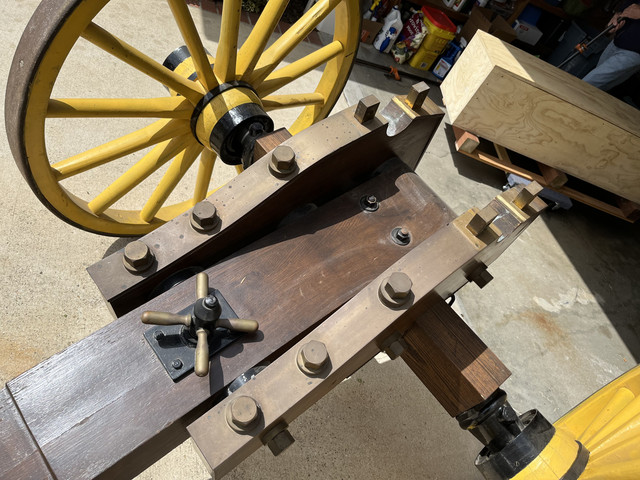
In keeping with the way I did the trunnion plates and their fasteners, the "cap squares" (caps that held the barrel trunnions down onto the trunnion plates) were held in place by specialized long bolts. The rear one was called a "chin bolt" and was really more of a hook that held the back end of the cap square down. The forward one was called a "key bolt". It had a slotted top that fit through a square hole in the forward end of the cap square. A "key" was inserted crosswise to hold the cap square down. Not having the wherewithal to make those parts way back when, I made heavy, 1 inch thick blocks of brass with 3/4 inch diameter cross pins to hold down my version of cap squares. Here is how they were installed.....
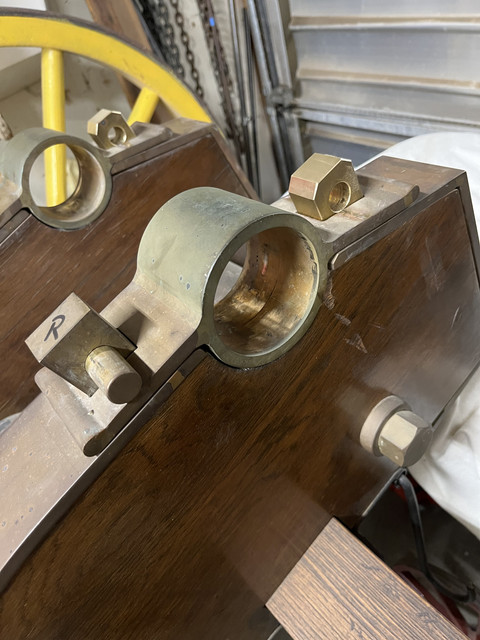
I'm going to keep those as well but I made them a little more graceful today by shortening them and knocking off the sharp corners. In addition, I cut a sort of a rounded key way in them and I will put small brass dowel pins perpendicular to the bodies of the four 3/4 inch cross pins to insure the cross pins don't fall out during transport.
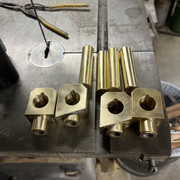
Not exactly HC.....but I would like to improve things a bit and yet not lose the character of how I did this a half a century ago.....

In keeping with the way I did the trunnion plates and their fasteners, the "cap squares" (caps that held the barrel trunnions down onto the trunnion plates) were held in place by specialized long bolts. The rear one was called a "chin bolt" and was really more of a hook that held the back end of the cap square down. The forward one was called a "key bolt". It had a slotted top that fit through a square hole in the forward end of the cap square. A "key" was inserted crosswise to hold the cap square down. Not having the wherewithal to make those parts way back when, I made heavy, 1 inch thick blocks of brass with 3/4 inch diameter cross pins to hold down my version of cap squares. Here is how they were installed.....

I'm going to keep those as well but I made them a little more graceful today by shortening them and knocking off the sharp corners. In addition, I cut a sort of a rounded key way in them and I will put small brass dowel pins perpendicular to the bodies of the four 3/4 inch cross pins to insure the cross pins don't fall out during transport.

Not exactly HC.....but I would like to improve things a bit and yet not lose the character of how I did this a half a century ago.....
Youngblood
40 Cal
- Joined
- Mar 31, 2022
- Messages
- 301
- Reaction score
- 362
I like that brass. You do good work Dave 
You built that when you were a junior in high school?!!
- Joined
- Mar 7, 2007
- Messages
- 700
- Reaction score
- 2,177
Youngblood....The gun looks REALY great when I take the time to polish all the brass...
Steve...Yes, I built the gun in high school...It might have been more useful if I had been thinking about cars and girls..... but I was a "late starter"
Zulu....At the time I built the gun I wasn't sure how I would even bend the cap squares out of brass or how I would bend the same 3/8" x 3" wide brass bar to follow the contour of the cheek. Somehow I managed to find some very thick walled brass pipe and cut off a 3 inch long piece. I machined the ID to match the trunnion on the barrel and then the OD to get the thickness I wanted. The plan was to cut ithe machined tube in half to make the curved part of the two cap squares by brazing pieces of bar onto both ends. I would make another couple of halves to braze into the trunnion plates. But when I sawed the first machined tube in half, it sprung open a fair amount and I wasn't smart enough to know about annealing. So the idea came to me to not cut the tubes.....just make the cap squares surround the trunnion. I couldn't see any reason I would want to take the cap squares off unless I needed to light the barrel anyway ....and if I needed to lift the barrel off the carriage, the cap squares could just come with it. So that is the long winded story of why the cap squares look like that and are not the traditional design. I haven't decided if I am going to correct that this time around yet or not.
Steve...Yes, I built the gun in high school...It might have been more useful if I had been thinking about cars and girls..... but I was a "late starter"
Zulu....At the time I built the gun I wasn't sure how I would even bend the cap squares out of brass or how I would bend the same 3/8" x 3" wide brass bar to follow the contour of the cheek. Somehow I managed to find some very thick walled brass pipe and cut off a 3 inch long piece. I machined the ID to match the trunnion on the barrel and then the OD to get the thickness I wanted. The plan was to cut ithe machined tube in half to make the curved part of the two cap squares by brazing pieces of bar onto both ends. I would make another couple of halves to braze into the trunnion plates. But when I sawed the first machined tube in half, it sprung open a fair amount and I wasn't smart enough to know about annealing. So the idea came to me to not cut the tubes.....just make the cap squares surround the trunnion. I couldn't see any reason I would want to take the cap squares off unless I needed to light the barrel anyway ....and if I needed to lift the barrel off the carriage, the cap squares could just come with it. So that is the long winded story of why the cap squares look like that and are not the traditional design. I haven't decided if I am going to correct that this time around yet or not.
A small cut in the cap squares front and back below the top would give the appearance of two separate pieces without causeing any additional work. Great project, and a long time in the making/finishing/modifying. I made some pretty neat stuff back in shop class, but no cannon!
- Joined
- Mar 7, 2007
- Messages
- 700
- Reaction score
- 2,177
Timber Wolf,
Good point ! But I may cut them completely and braze all the parts up the way they should be.....
Good point ! But I may cut them completely and braze all the parts up the way they should be.....
Treestalker
Treestalker
- Joined
- Mar 24, 2014
- Messages
- 4,051
- Reaction score
- 3,748
- Location
- Third Pond from the Great God Helios
I couldn't even tie my shoes 'til I was in the second grade, LOL!You built that when you were a junior in high school?!!
Treestalker
Treestalker
- Joined
- Mar 24, 2014
- Messages
- 4,051
- Reaction score
- 3,748
- Location
- Third Pond from the Great God Helios
The high school I attended was in the backwater, forlorn metropolis of Vidor, Texas. We boys couldn't even grope a girlfriend much less build a gun in that benighted place. The town was only known for being a hotbed of the KKK, and the story was they didn't even allow color TV's...A small cut in the cap squares front and back below the top would give the appearance of two separate pieces without causeing any additional work. Great project, and a long time in the making/finishing/modifying. I made some pretty neat stuff back in shop class, but no cannon!
- Joined
- Mar 7, 2007
- Messages
- 700
- Reaction score
- 2,177
Well....it's been a long while since I had time to work on the big gun, but I've had a chance to start in again. Even though I went through the trouble to build a giant reamer and true up the bore, I still didn't like the stepped diameters at the last 6 inches of the breech. That was the way the barrel came in 1970 from Barney's Cannons, but I never really liked it and it did cause loading issues. So I got in touch with Barney's professional progeny, Jim Olsen, at what is now South Bend Replicas. After a long and delightful conversation, Jim agreed to rebore the barrel and then line it with a seamless steel tube. I kept the bore the same 2.75 inches although I had briefly thought about taking it up to 3 inches.....but then, the gun is expensive enough to shoot without increasing the ball size and powder charge. So, having a partial attack of sanity, I stuck with the original bore size.
I built a heavy duty crate and then shipped the barrel via Yellow Freight to South bend Indiana a few months ago and left it in Jim's tender care. It just came back a few days ago and I managed to get the crate home and open it up. Jim did a fantastic job and now I'm anxious to get the rest of the carriage work done so I can re-mount the barrel. Here are a few photos of the gun coming back home.....
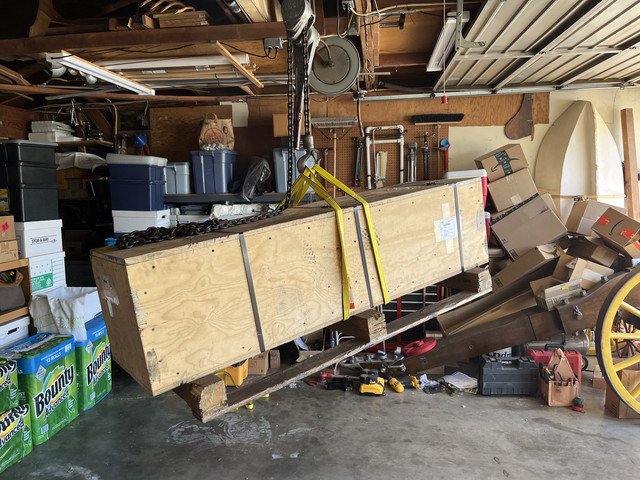
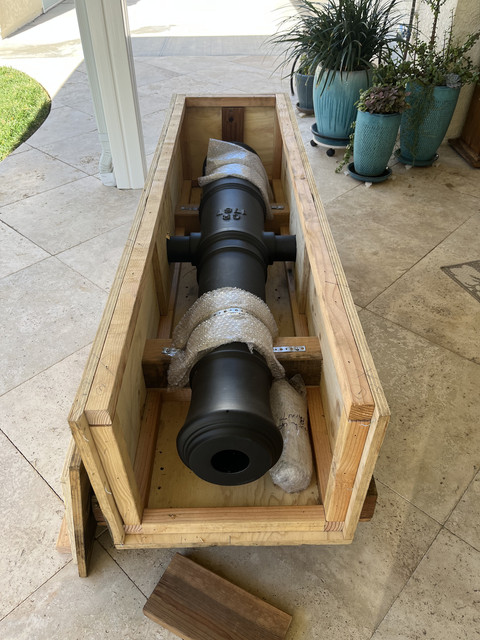
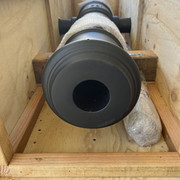
I built a heavy duty crate and then shipped the barrel via Yellow Freight to South bend Indiana a few months ago and left it in Jim's tender care. It just came back a few days ago and I managed to get the crate home and open it up. Jim did a fantastic job and now I'm anxious to get the rest of the carriage work done so I can re-mount the barrel. Here are a few photos of the gun coming back home.....



Similar threads
- Replies
- 7
- Views
- 566




